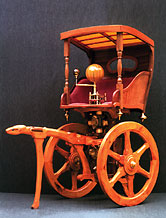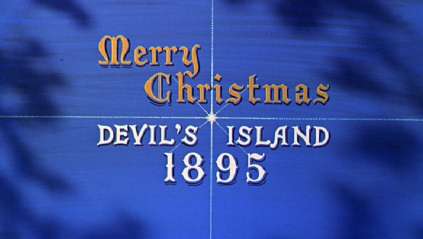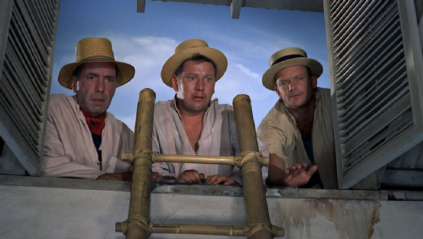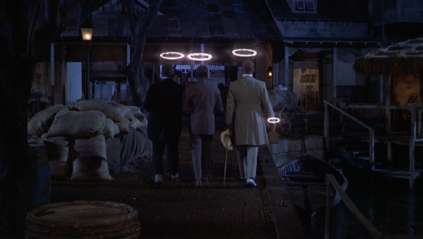- Home
- Forums
- CIVILIZATION III
- Civ3 - Creation & Customization
- Civ3 - Project & Mod Development
- Civ3 - Steampunk Scenario
You are using an out of date browser. It may not display this or other websites correctly.
You should upgrade or use an alternative browser.
You should upgrade or use an alternative browser.
ARCHIVED: Fun Stuff
- Thread starter KingArthur
- Start date
- Status
- Not open for further replies.
Blue Monkey
Archon Without Portfolio
Came across a blog about a box that only unlocks at a specific geographic location & guides you toward that location in a general way. (click picture for link)

Reminded me immediately of the South-Pointing Chariot. (click picture...)

There's at least a UU there. Put them together & maybe even a GW.


Also: Steampunk Iron Man won the Marvel Costume Contest at the New York Comic Con 2010.


Reminded me immediately of the South-Pointing Chariot. (click picture...)

There's at least a UU there. Put them together & maybe even a GW.


Also: Steampunk Iron Man won the Marvel Costume Contest at the New York Comic Con 2010.

Blue Monkey
Archon Without Portfolio

New & Upcoming Steampunk books:
Flaming Zeppelins - I've read one of these stories. Way over the top & a lot of fun.
Steampunk Bible If you're familiar with Jeff VanderMeer you know what to expect.
Steampunk'd anthology of original stories edited by Martin H. Greenberg
Steampunk Prime: A Vintage Steampunk Reader stories written between 1880 and 1914
Steampunk: Victorian Futurism on the current artistic movement
Visualising Steampunk about visual design (as in concept art for films)
Fuel For The Boiler: A Steampunk Cookbook as my cousin used to say "what thee heck!?"
Steampunk Bible If you're familiar with Jeff VanderMeer you know what to expect.
Steampunk'd anthology of original stories edited by Martin H. Greenberg
Steampunk Prime: A Vintage Steampunk Reader stories written between 1880 and 1914
Steampunk: Victorian Futurism on the current artistic movement
Visualising Steampunk about visual design (as in concept art for films)
Fuel For The Boiler: A Steampunk Cookbook as my cousin used to say "what thee heck!?"
Balthasar
Wise Man
- Joined
- Mar 11, 2005
- Messages
- 3,293
Catching up on Fun Stuff, last first:
This list dictates a trip to the bookstore, at last. Just to look, as I'm short of that kind of cash.
Re: the picture in post 161, first published October 1888, a month after the death of Annie Chapman, the fourth of the Whitechapel Murders. Quite a bit to write about it. First, the picture of the suspect is that of the man described by Emily Marsh and by one of the Sons of George Lusk as having asked for Lusk's address just prior to Lusk's receiving the "From Hell" letter, from JTR, i.e., a tall bearded man with a soft hat and long overcoat. Lusk was also one of the co-founders and Chairman of the Whitechapel Vigilance Committee depicted in the illustration!
There is, however, another eyewitness description: that of Elizabeth Long, who described a tall man wearing a deerstalker cap and long overcoat talking to Annie Chapman shortly before her murder. The cap is an unusual detail as deerstalkers were rarely worn in urban streets.

Annie Chapman
The plot thickens: even more startling is the fact that the first Sherlock Holmes story, A Study in Scarlet was published in 1887, a year before the Whitechapel murders, but the first illustration (by Sidney Paget) of Holmes in a deerstalker cap didn't appear until the publication of the story "The Boscombe Valley Mystery" in 1893. Watson tells us in A Study in Scarlet that Holmes moved to 221B Baker St in 1881.
So what was Holmes role in the Ripper Murders? Why are they never mentioned in the stories despite ample evidence that he was actively consulting at the time? Did he participate? Did he investigate? Was it the only case he couldn't solve? Or did he solve it, only to discover that the truth could never be revealed?
This list dictates a trip to the bookstore, at last. Just to look, as I'm short of that kind of cash.
Re: the picture in post 161, first published October 1888, a month after the death of Annie Chapman, the fourth of the Whitechapel Murders. Quite a bit to write about it. First, the picture of the suspect is that of the man described by Emily Marsh and by one of the Sons of George Lusk as having asked for Lusk's address just prior to Lusk's receiving the "From Hell" letter, from JTR, i.e., a tall bearded man with a soft hat and long overcoat. Lusk was also one of the co-founders and Chairman of the Whitechapel Vigilance Committee depicted in the illustration!
There is, however, another eyewitness description: that of Elizabeth Long, who described a tall man wearing a deerstalker cap and long overcoat talking to Annie Chapman shortly before her murder. The cap is an unusual detail as deerstalkers were rarely worn in urban streets.

Annie Chapman
The plot thickens: even more startling is the fact that the first Sherlock Holmes story, A Study in Scarlet was published in 1887, a year before the Whitechapel murders, but the first illustration (by Sidney Paget) of Holmes in a deerstalker cap didn't appear until the publication of the story "The Boscombe Valley Mystery" in 1893. Watson tells us in A Study in Scarlet that Holmes moved to 221B Baker St in 1881.
So what was Holmes role in the Ripper Murders? Why are they never mentioned in the stories despite ample evidence that he was actively consulting at the time? Did he participate? Did he investigate? Was it the only case he couldn't solve? Or did he solve it, only to discover that the truth could never be revealed?
Spoiler :
Postscript: The man described by Lusk's son reportedly spoke with an Irish accent; in a letter published in the Daily Telegraph Sept. 10, 1888 (two days after Chapman's murder) announcing the formation of the Vigilance Committee and addressed to the Home Secretary, the Committee asks that a reward be offered for the murderer which would "convince the poor and humble residents of our East-end that the government authorities are as much anxious to avenge the blood of these unfortunate women as they were the assassination of Lord Cavendish and Mr Burke."
Burke and Cavendish were victims of the 1882 Phoenix Park Murders in which the murderers slashed the throats and chests of their victims with surgical knives. The whole thing was tied to the issue of Irish home rule. Although both politicians generally supported home rule, the murders were pinned on a little-known Irish Republican group called the Irish National Invincibles.
The Phoenix Park Murders occurred just days after the signing of the Kilmainham Treaty made between the government of William Gladstone and Irish Nationalist Leader Charles Stewart Parnell. The Treaty was widely viewed as a repudiation of the Coercion Acts authored by William Forster, then Chief Secretary for Ireland. The Coercion Acts allowed the brutal repression of poor Irish tenant farmers, earning Forster the nickname "Buckshot". Forster had Parnell arrested in October 1881, but when Gladstone announced the Kilmainham Treaty May 2, 1882, Forster resigned; Lord Frederick Cavendish was named to replace him and was killed in Phoenix Park just four days later. The murders finally doomed the cause of Irish home rule; Gladstone's minister Lord Hartington was the older brother of Cavendish and turned against the cause, eventually splitting with Gladstone and forming the Liberal Unionist Party which joined with the Conservatives to defeat Gladstone in 1886. It set back the cause of Irish Home Rule 28 years and the ensuing Plan of Campaign led to further escalation of the land war including the Mitchelstown massacre in 1887.
Although Charles Parnell had denounced the Phoenix Park murders, in March, 1887 The Times began a series of articles accusing Home Rule League leaders of supporting murder and outrage in Ireland. In particular, they printed a letter from Parnell to a fenian leader that included "Though I regret the accident of Lord F Cavendish's death I cannot refuse to admit that Burke got no more than his deserts". Parnell denounced the letter as a "villainous and barefaced forgery". On that very same day the Perpetual Crimes Act, a reinstitution of the Coercion Acts, was debated and passed in the House of Commons.
After much argument the Government finally set up the Parnell Commission to investigate the letters sent to the Times. They were to begin their proceedings September 14, 1888, four days after the Vigilance Committee sent it's letter to the Daily Telegraph and exactly one week after the death of Annie Chapman.
It was only a few weeks later (Sept 27) that the Central News Agency received the "Dear Boss" letter that referenced statements made by Lusk and from which the name "Jack the Ripper" comes. On Oct. 16, Lusk himself reported that he'd received a small box with a kidney inside and the "From Hell" letter. That was three days after the "Vigilance Committee" picture was published.
The following February, 1889, an Irish journalist, Richard Piggott, admitted to the Parnell Commission that he'd forged the Parnell letters. He then fled to Madrid and shot himself in the head.
Despite the fact that the only witness descriptions of the potential murderer describe a man speaking with an Irish accent, and despite the exaggerated "theater Irish" in the 'From Hell' letter, the public seized on statements that suggested that the murderer was Jewish, and violent anti-semitic riots ensued.
To the best of my knowledge, no connection between the Phoenix Park Murders, Lusk, and the Parnell forgeries has ever been made.....
Burke and Cavendish were victims of the 1882 Phoenix Park Murders in which the murderers slashed the throats and chests of their victims with surgical knives. The whole thing was tied to the issue of Irish home rule. Although both politicians generally supported home rule, the murders were pinned on a little-known Irish Republican group called the Irish National Invincibles.
The Phoenix Park Murders occurred just days after the signing of the Kilmainham Treaty made between the government of William Gladstone and Irish Nationalist Leader Charles Stewart Parnell. The Treaty was widely viewed as a repudiation of the Coercion Acts authored by William Forster, then Chief Secretary for Ireland. The Coercion Acts allowed the brutal repression of poor Irish tenant farmers, earning Forster the nickname "Buckshot". Forster had Parnell arrested in October 1881, but when Gladstone announced the Kilmainham Treaty May 2, 1882, Forster resigned; Lord Frederick Cavendish was named to replace him and was killed in Phoenix Park just four days later. The murders finally doomed the cause of Irish home rule; Gladstone's minister Lord Hartington was the older brother of Cavendish and turned against the cause, eventually splitting with Gladstone and forming the Liberal Unionist Party which joined with the Conservatives to defeat Gladstone in 1886. It set back the cause of Irish Home Rule 28 years and the ensuing Plan of Campaign led to further escalation of the land war including the Mitchelstown massacre in 1887.
Although Charles Parnell had denounced the Phoenix Park murders, in March, 1887 The Times began a series of articles accusing Home Rule League leaders of supporting murder and outrage in Ireland. In particular, they printed a letter from Parnell to a fenian leader that included "Though I regret the accident of Lord F Cavendish's death I cannot refuse to admit that Burke got no more than his deserts". Parnell denounced the letter as a "villainous and barefaced forgery". On that very same day the Perpetual Crimes Act, a reinstitution of the Coercion Acts, was debated and passed in the House of Commons.
After much argument the Government finally set up the Parnell Commission to investigate the letters sent to the Times. They were to begin their proceedings September 14, 1888, four days after the Vigilance Committee sent it's letter to the Daily Telegraph and exactly one week after the death of Annie Chapman.
It was only a few weeks later (Sept 27) that the Central News Agency received the "Dear Boss" letter that referenced statements made by Lusk and from which the name "Jack the Ripper" comes. On Oct. 16, Lusk himself reported that he'd received a small box with a kidney inside and the "From Hell" letter. That was three days after the "Vigilance Committee" picture was published.
The following February, 1889, an Irish journalist, Richard Piggott, admitted to the Parnell Commission that he'd forged the Parnell letters. He then fled to Madrid and shot himself in the head.
Despite the fact that the only witness descriptions of the potential murderer describe a man speaking with an Irish accent, and despite the exaggerated "theater Irish" in the 'From Hell' letter, the public seized on statements that suggested that the murderer was Jewish, and violent anti-semitic riots ensued.
To the best of my knowledge, no connection between the Phoenix Park Murders, Lusk, and the Parnell forgeries has ever been made.....
Blue Monkey
Archon Without Portfolio
At the very least there are the interpretations in Murder By Decree and Shadow Of Reichenbach Falls. I find a much richer (and more steampunkish) interpretation of the possible connections (extending to the vampyric) in Supping With Panthers (US title: Slave Of My Thirst). No canonical names are mentioned, but the protagonist is a doctor who had served with the military in the Northwest Frontier & returned with troublesome wounds both physical & psychological.So what was Holmes role in the Ripper Murders? Why are they never mentioned in the stories despite ample evidence that he was actively consulting at the time? Did he participate? Did he investigate? Was it the only case he couldn't solve? Or did he solve it, only to discover that the truth could never be revealed?
Balthasar
Wise Man
- Joined
- Mar 11, 2005
- Messages
- 3,293
There were several contemporary stories of the involvement of a soldier in the crimes including several that fit Watson's description. As for my own theory, I've added it to my previous post in spoilers.
Michael Dibdin's The last Sherlock Holmes story is the best version of Holmes-and-Ripper that I know of. In some ways it makes more sense of Holmes himself, and especially of The adventure of the final problem (which in itself is really rather silly), than Conan Doyle does.
Blue Monkey
Archon Without Portfolio
Glad you mentioned Dibdin. I stuck to only mentioning stories I've actually seen/read.Michael Dibdin's The last Sherlock Holmes story is the best version of Holmes-and-Ripper that I know of. In some ways it makes more sense of Holmes himself, and especially of The adventure of the final problem (which in itself is really rather silly), than Conan Doyle does.
EDIT: The best explanation for Holmes' bee obsession in his retirement, imho, is to be found in "The Horror of the Many Faces" (on-line text). It may also explain the Ripper connection, and why his solution was never announced.
Glad you mentioned Dibdin. I stuck to only mentioning stories I've actually seen/read.
Definitely look out for it. It's many years since I read it and I spent some considerable time leafing through it again after posting that comment. It's really quite brilliant, with a re-interpretation of Holmes that's so convincing you'd almost think Conan Doyle intended it himself.
Conan Doyle is actually referred to (though doesn't appear) as a character; it's narrated by Watson in the standard way, but we're told that the published Holmes stories are written by Conan Doyle in a semi-fictionalised way based on Watson's notes of the genuine cases. Holmes doesn't approve:
What is not known is Holmes's response to A.C.D.'s 'A Study in Scarlet'. I must admit that I felt at once that the title was not going to meet with my friend's approval. His own suggestion, duly passed on by me, had been 'Towards a Definitive Praxis of Applied Criminal Anthropology: Some Notes on the Stangerson-Drebber Murders of 1881'.
Also, Watson wondering whether or not to go home:
221B or not 221B? That was the question...
Just wittily written, and as I say, not just a brilliant pastiche of Conan Doyle but doing something very interesting with the character that drives you back to the original stories.
KingArthur
Searching for the Holy Grail
Balthasar
Wise Man
- Joined
- Mar 11, 2005
- Messages
- 3,293
Oh yes. And then my favorite: The Incredible Hulking Man

From the League of Marvels Collection. The idea for our Steampunk Commando ('The Falcon') came from this set.

From the League of Marvels Collection. The idea for our Steampunk Commando ('The Falcon') came from this set.
Blue Monkey
Archon Without Portfolio
I've been watching some of my favorite Yuletide films. Other than the 5 million versions of Dickens' Christmas Carol, can anyone think of a steampunkish holiday film? Here's three clues (increasingly obvious) to the closest I could come up with:
Clue 1

Clue 2

Clue 3

Clue 1
Spoiler :

Clue 2
Spoiler :

Clue 3
Spoiler :

Blue Monkey
Archon Without Portfolio
If you recognize any of the actors there's always ixquick.  If no one guesses I'll give the answer in a couple of days. Any suggestions for a Steampunk Christmas?
If no one guesses I'll give the answer in a couple of days. Any suggestions for a Steampunk Christmas?
30 C at night! That sounds like So. California in the summer. After a few years of drought we're finally getting rain. Going on 2 weeks so far. Haven't had so many days in a row since I was a kid.
 If no one guesses I'll give the answer in a couple of days. Any suggestions for a Steampunk Christmas?
If no one guesses I'll give the answer in a couple of days. Any suggestions for a Steampunk Christmas?30 C at night! That sounds like So. California in the summer. After a few years of drought we're finally getting rain. Going on 2 weeks so far. Haven't had so many days in a row since I was a kid.
Balthasar
Wise Man
- Joined
- Mar 11, 2005
- Messages
- 3,293
It doesn't really count as steampunk, but one of my fav X-mas flics is Santa Claus Conquers The Martians, a movie I saw as a kid, and which regularly hits the "Worst Movie of all Time" lists*. For extra enjoyment, find and watch the Mystery Science Theater episode that features that movie....
Edit: It seems that most of the original cast of MST is now involved in a new group called Cinematic Titanic that does live shows. They've recorded a new riff on SC v. Mars, so my stocking over-floweth......
Edit: It seems that most of the original cast of MST is now involved in a new group called Cinematic Titanic that does live shows. They've recorded a new riff on SC v. Mars, so my stocking over-floweth......
Butterball
Bear
Seasons Greetings & Happy New Year.
I've just read 20 000 siècles sous les mers (Twenty Thousand Centuries Under the Sea), a recent (last october) French comics starring Captain Nemo and Prof. Aronnax in an undersea adventure where Innsmouth isn't just a small decaying village.

It's a nice read. The story is quite classic but good We'll see how it ends in the second and final issue. There are small nods here and there to a good bunch of literature and movie works. Not as much as Moore's League, but enough to keep me smiling and exclaiming myself. Overall, if you like steampunkish crossover, you can get it without regrets.
By R. D. Nolane (story) and P. A. Dumas (illustrations).
Soleil Editions, 1800 Collection, 48 p.
BM > That's "We're no angels". A good flick, but I fail to see how it's steampunk, though.
Spoiler :

It's a nice read. The story is quite classic but good We'll see how it ends in the second and final issue. There are small nods here and there to a good bunch of literature and movie works. Not as much as Moore's League, but enough to keep me smiling and exclaiming myself. Overall, if you like steampunkish crossover, you can get it without regrets.
By R. D. Nolane (story) and P. A. Dumas (illustrations).
Soleil Editions, 1800 Collection, 48 p.
BM > That's "We're no angels". A good flick, but I fail to see how it's steampunk, though.
Blue Monkey
Archon Without Portfolio
You're a gentleman & a scholar! I agree it's not steampunk - just the only holiday film I could think of that even came close. OTOH, we never see what kind of ships are used for the import/export business, or even if they are air- or sea- going vessels. A little of this, a little Great Train Robbery (Connery instead of Aldo Ray?), and a little 19th c. Topkapi... it'll be great when making new films with deceased actors becomes common.BM > That's "We're no angels". A good flick, but I fail to see how it's steampunk, though.

I've got a better match, even if most of the action takes place in modern times : Santa Claus : The Movie (1985 - Jeannot Szwarc). Although it involves probably more magic than classic steampunk technology, you cannot see the Vendequm workshop and not feel a certain Victorian charm. Maybe it's because I first saw this movie as a kid around the same time I watched Levin's Journey to the Center of the Earth (1959) and Endfield's Mysterious Island (1961).
Blue Monkey
Archon Without Portfolio
Any suggestions for a Steampunk Christmas?
It doesn't really count as steampunk, ...
If only I had a TARDIS when I was watching films to get in the holiday mood...I've got a better match, even if most of the action takes place in modern times ....
wrapping
Spoiler :

present
Spoiler :

tag
Spoiler :
Can't have everything...Other than the 5 million versions of Dickens' Christmas Carol,...

- Status
- Not open for further replies.
Similar threads
- Replies
- 6
- Views
- 2K
- Replies
- 2
- Views
- 3K
- Replies
- 4
- Views
- 416
- Replies
- 12
- Views
- 7K

